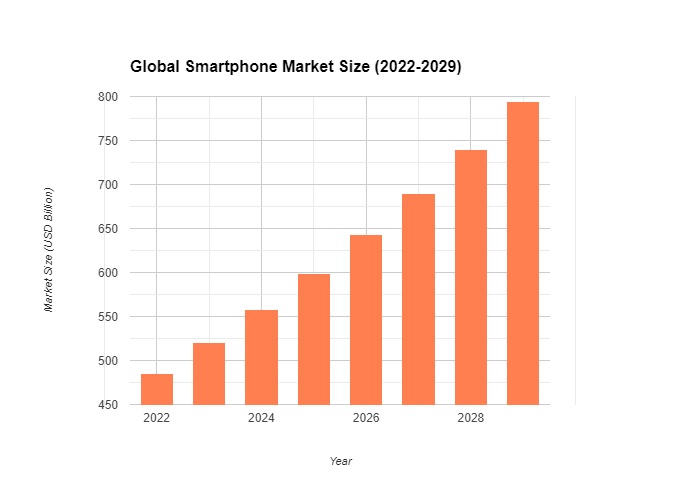Smartphones have become an undeniable cornerstone of modern life, seamlessly integrating into our work, entertainment, and communication. This article delves into the current state of the ever-evolving smartphone market, exploring its size, market share, growth trajectory, and the key trends shaping its future.
Smartphone Market Size and Share:
The smartphone market boasts a remarkable size, reaching a staggering USD 484.81 billion in 2022 and projected to reach USD 792.51 billion by 2029, exhibiting a healthy CAGR of 7.3%. This growth can be attributed to several factors, including:
- Rising disposable income: Increasing disposable income, particularly in developing economies, empowers individuals to invest in sophisticated smartphones.
- Technological advancements: Continuous advancements in display technology, camera capabilities, processing power, and battery life fuel consumer demand for the latest smartphones.
- Expanding internet penetration: Growing accessibility to high-speed internet globally drives the need for advanced devices to access online services and applications.

The market share is dominated by a few major players, with Samsung and Apple holding a combined share of over 50%. These giants consistently innovate and offer premium flagship devices, attracting a loyal customer base. However, the market is becoming increasingly competitive with established players like Xiaomi, Oppo, Vivo, and others making significant strides, particularly in the mid-range and budget segments.
Smartphone Sector Growth and Revenue:
The smartphone sector is expected to witness continued growth, driven by the factors mentioned above. The projected CAGR of 7.3% translates to a market size exceeding USD 792.51 billion by 2029. This growth will be fueled by:
- Emerging markets: Developing economies like India, Southeast Asia, and Africa will be key drivers of market growth as smartphone penetration increases.
- 5G technology adoption: The widespread adoption of 5G networks will create demand for next-generation smartphones capable of handling faster data speeds and enabling innovative applications.
- Focus on innovation: Smartphone manufacturers will continue to invest in research and development, focusing on areas like foldable displays, artificial intelligence integration, and enhanced camera functionalities.
Smartphone Industry Trends:
Several trends are shaping the future of the smartphone industry:
- Artificial intelligence (AI) integration: AI features like facial recognition, voice assistants, and intelligent camera functionalities are becoming increasingly sophisticated, transforming user experience.
- Focus on foldable displays: Foldable phones continue to evolve, offering a unique user experience and potentially disrupting the traditional smartphone form factor.
- Sustainability initiatives: Consumers are increasingly environmentally conscious, prompting smartphone manufacturers to adopt eco-friendly practices and materials in device production and packaging.
- Rise of the “phygital” experience: The integration of online and offline shopping experiences, where physical and digital elements combine, is influencing smartphone sales strategies.
Smartphone Market Players:
The smartphone market landscape features a diverse range of players. Established giants like Samsung and Apple remain dominant forces, while Chinese manufacturers like Xiaomi, Oppo, and Vivo are gaining significant market share, particularly in the affordable segment. Additionally, niche players like Google with its Pixel series and emerging brands are catering to specific consumer segments.
Smartphone Market Future Outlook:
The future of smartphone market appears bright, with continued growth and innovation anticipated. As technology advancements accelerate, user demands evolve, and emerging markets expand, the industry will see further diversification and competition.
However, challenges in the form of chip shortages, supply chain disruptions, and rising manufacturing costs will need to be addressed to ensure sustained growth. Additionally, navigating the evolving regulatory landscape across different geographical regions remains a challenge for smartphone manufacturers.
In conclusion, the smartphone market remains a dynamic and vital sector within the global technology landscape. By embracing innovation, catering to diverse consumer needs, and prioritizing sustainability, smartphone manufacturers can ensure their success in the ever-unfolding story of this ever-present device. As technology continues to progress and user expectations change, the smartphone of tomorrow promises to be even more sophisticated, versatile, and seamlessly integrated into our lives.




